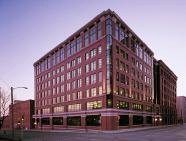|
Milwaukee’s Waves of Change
This summer, hundreds of thousands of Harley Davidson motorcycles roared into their birthplace to celebrate the Milwaukee company’s 100th anniversary. But Milwaukee is spending a lot less time looking back these days.
To be sure, manufacturing’s presence in Cream City has been dwindling right along with the city’s signature breweries, losing 30,000 factory jobs since 1998 and bringing Milwaukee County’s projected industrial vacancy rate to more than 6 percent in 2003.


Johnson Controls’ Brengel Technology Center (above, top) is the showpiece for downtown Milwaukee. The Menomonee Valley (bottom) could be the next wave in the city’s rebirth.
|
|
But some corporate denizens are more convinced than ever that Milwaukee’s center city is the right place to be – in part because so many talented, dependable people think the same thing. While the larger metro’s population de-clined by 5 percent between 1990 and 2000, downtown’s increased by 25 percent.
Just ask Roundy’s Corp., which recently made a high-profile choice to relocate downtown after a self-declared suburban exile that began in 1954. GE Medical Systems‘ IT division, also headquartered in the suburbs, is seriously considering a major expansion move that could bring 1,500 jobs and be the tipping point for a whole new downtown era. Waiting there to greet them is worldwide facility management leader and automotive supplier Johnson Controls.
One can look to the city’s newspaper of record, the Journal Sentinel, for further evidence of growth. In the Village of West Milwaukee, the paper has constructed a $112-million, 448,750-sq.-ft. (41,689-sq.-m.) printing facility.
Power, rail and mass transit access were key to the 42-acre (17-hectare) site selection. One of a handful of big newspaper printing projects in the past few years (Omaha, Dayton, Kansas City, Chicago, Miami), the project involved more than $7 million of environmental investigation and remediation. The finished facility allows the company to consolidate functions like distribution, reduce volatile organics emissions and increase the paper’s production capacity by more than 240 percent.
Tying It All Together
Not far away lies Menomonee Valley, a mixture of old industrial and railyard land that’s about the size of New York’s Central Park. When redeveloped, it will provide an ideal link between downtown, the freeway and Miller Park, home of Major League Baseball’s Milwaukee Brewers. The Valley already boasts the new $7-million headquarters of Sigma Environmental Corp., and will soon see another investment by shoe maker Allen Edmonds. A 140-acre (57-hectare) parcel long in dispute between the city and a Chicago investment group may be finally seeing the light of day for redevelopment by the end of the year.
At the heart of this kaleidoscope of change is the popular “live, work, play” concept – a model many cities are pursuing, but only a handful are attaining. One factor in Milwaukee’s favor? The 2,000 members of its nascent young professionals group, who are more likely to address real issues than merely mix and mingle after hours. In fact, one of those young professionals – Cory Nettles, 32 – was appointed Wisconsin Secretary of Commerce in January 2003.
“Businesses want to be in environments that are dynamic, energetic, where people are aggressively pursuing opportunities and change, as opposed to sitting back passively and letting things happen,” he tells Site Selection. “That’s especially true for those businesses in the knowledge-based economy.”
Wisconsin has a reputation for being a high-tax state, says Nettles, “and we want to fall off that list.” He is also high on the concept of regional thinking, whereby triads of metros like Chicago-Milwaukee-Madison or Milwaukee-Madison-Twin Cities work together in some respects. He cites the potential for such collaboration in the medical device industry, which quadrupled its exports from Wisconsin in 2002.
Lame-duck Mayor John Norquist is literally riding the progressive city wave out of town, taking the post of president of the Congress for the New Urbanism, which is moving its headquarters from San Francisco to Chicago. His long-range plan for Milwaukee hinged on 13 projects that include new transit alternatives and accentuation of the city’s unique natural assets: the Milwaukee River and Lake Michigan. City Planning Director Peter Park says the reorganization of city departments has brought the waiting time on zoning appeals from 28 weeks in 1996 to around one month today.
In Norquist’s wake comes the next wave. Nearly complete, the demolition of the Park East freeway spur is freeing 26 acres (10.5 hectares) for an expected $250 million of mixed-use development. Nearby, the 25-building former Pabst brewery is on the brink of its own redevelopment. And the $810-million Marquette interchange renovation is just about to get started.
Like the view from its Santiago Calatrava-designed art museum, Milwaukee’s outlook is opening up to wide and renewed horizons. — Adam Bruns |
|
Will ‘Do Not Call’ Mean ‘Do Not Build’?
The initial sign-up period for the Federal Trade Commission’s national “Do Not Call” (DNC) registry elicited enrollment from 48.4 million consumers, many of them imported from state lists. That dramatic number has in turn elicited cries of outrage from the telemarketing industry, which has predicted the subsequent loss of up to 2 million jobs, should a court decision barring the registry be overturned.

Monica Hoover, right, of Spherion Corp., celebrates the opening of a new $6-million bilingual call center in Panama with Panamanian President Mireya Moscoso (to her right) and other company and country dignitaries.
|
|
“Without a doubt, the DNC legislation will impact outbound,” says Amit Shankardass, solution planning officer with Nashville based ClientLogic, which operates 47 facilities worldwide, 33 of them call centers. “I absolutely believe there will be some overcapacity of labor and of call centers as a result of this.”
However, indications from a facility development perspective are that a business model evolution was already under way. One expert pegs the inbound side of the business at four times the size of its outbound counterpart.
“Fortunately, ClientLogic’s business is in vast majority inbound,” says Shankardass. “About three years ago, acquisition was the buzzword. Today, it’s increasing revenue per customer, and acquisition of desirable consumers.”
Indeed, companies that formerly may have thrown money and people at telemarketing efforts have long since moved towards an integrated approach that seeks to blend new offers with old-fashioned customer service. Numbers from Conway Data’s New Plant Database show 36 customer contact center projects announced from January through June 2003, with the vast majority slated for servicing inbound calls. They will employ more than 6,000 people, backed by an investment of some $346 million.
Among projects announced over the summer were Spherion‘s $6-million, 200-employee, 50,000-sq.-ft. (4,645-sq.-m.) bilingual call center in Panama City, Panama; a 550-employee customer service center in Amarillo, Texas, for Blue Cross and Blue Shield of Texas; Cingular‘s new center in Jacksonville; Phase 2 Solutions‘ 125-employee center in Minot, N.D.; and T-Mobile‘s tripling of its work force to 600 at its Birmingham, Ala., operation.
Jeff Furst, president of Chicago-based call center consultancy FurstPerson, does not foresee much new building over the next two years, but says that more sophisticated companies have already migrated to a blended approach. Furst says the 2-million-worker figure could indeed be accurate, and regrets that the downsizing of that outbound work force is being driven by legislation instead of market forces. But he does acknowledge one promising trend and one unarguable truth.
“Call center jobs will become more complex and require a higher-caliber worker,” says Furst. “You may have one less opportunity with that customer, so to convert it into some type of revenue opportunity becomes even more important.”
And the undisputed fact?
“Telemarketing,” he says, “is a hard, hard job.” — Adam Bruns
|
|
Big Sale-Leasebacks Make Financial Sense
American Financial Realty Trust (AFRT) on June 30 completed its IPO for an aggregate $804.3 million. On July 1, that cash was quickly turned around, in a $769.8-million purchase of 158 office buildings, banking and operations centers from Bank of America (BOA). Of the 8.1 million sq. ft. (752,490 sq. m.) sold, BOA will lease back 5.2 million sq. ft. (483,080 sq. m.) or 64 percent of the total space. The 20-year, triple-net agreement rids BOA of about 2 million sq. ft. (185,800 sq. m.) of vacant space, while also disposing of its landlord responsibilities.
In an odd personnel twist to the sale-leaseback concept, the company in July also announced that its Louisville mortgage-servicing operation would be shuffled off to Buffalo, N.Y., and Greensboro, N.C. But the 770 employees in Louisville aren’t going anywhere. That’s because a newly formed Charlotte-based joint venture between BOA and California title company Fidelity National Financial – Financial ServiceSolutions – is going to sublease the 150,000 sq. ft. (13,935 sq. m.) that BOA currently occupies in the River City. Greg Sullins, CEO of Financial ServiceSolutions, says the Louisville payroll could increase to as many as 1,000 people by the end of 2004.
Then there is the “back-to-back” leaseback. In July, Bermuda-based XL Capital, known for its environmental insurance business, consolidated eight offices and more than 500 staff members by purchasing a 195,000-sq.-ft. (18,116-sq.-m.) building in London for $182 million. But it was just getting started. After leasing 60,000 sq. ft. (5,574 sq. m.) back to retailer and original seller Marks & Spencer, XL sold the building for $237 million to Synergy Gracechurch Ltd., a company formed, financed and managed by Active Asset Investment Management, a new property advisory and fund management company backed in part by British investor Sir Alex Ferguson, of Manchester United and Thoroughbred racing fame. XL then promptly signed its own 25-year lease. In effect, say Cushman & Wakefield brokers who oversaw the deal, XL made money in the turnaround by adding value with its own occupancy – a variation of the same financial model behind tax-increment financing.
The move followed on the similar June 2003 move of the company’s Swiss insurance operations (300 staff) from the city of Winterthur to Zurich. There too, company leaders cited the city’s international reputation in financial circles. – Adam Bruns
|

|



